5.4.4 Replay equipment: Professional Reel Machines
5.4.4.1 As analogue reel tape has been the mainstay of the sound recording and archiving community for decades the virtual cessation of the manufacture of reel player/recorders is a major crisis in the sound archiving community. Very few new professional tape machines are currently available from manufacturers, possibly only from Otari who continue to make a single machine, which may be described as the third generation of their mid-range model when compared to their earlier range, and Nagra Kudelski, who still list two portable field recording analogue tape machines as available. Not all machines meet the necessary replay specification (below) and archives must check for compliance before making a purchase. The alternative is to purchase and restore second hand machines, and the market in high end analogue reel machines is quite strong. It is recommended that only widely used machines should be purchased as this will facilitate the acquisition of parts and maintenance. The characteristics of a suitable archival reel machine include the following:
5.4.4.2 Reel Replay Speeds: The standard tape speeds are as follows: 30 ips (76.2 cm/s), 15ips (38.1 cm/s), 7.5 ips (19.05 cm/s), 3¾ ips (9.525 cm/s), 1 7⁄8 ips (4.76 cm/s) and 15⁄16 ips (2.38 cm/s). The need to replay all these speeds will depend on the makeup of the individual collections. No single machine will play all 6 speeds, but it is possible to cover all speeds with two machines.
5.4.4.3 Mono and stereo 1/4 inch recording equipment come in 3 basic track configurations; full track, 1/2 track and 1/4 track. There are variations in the actual track width according to the particular standard. A tape replayed with a head with less replay width than the actual recorded track width will exhibit an altered low frequency response known as the fringe effect, and show poorer signal to noise than optimum. So a recorded track width of 2.775mm replayed with a 2mm stereo head will result in a loss of signal to noise ratio of approximately 2dB. The fringe effect is of the order of about +1dB at 63 Hz at 19.05 cm/s (7.5 ips) (McKnight 2001). A tape replayed with a head with a wider replay width than the actual recorded track width will exhibit slightly worse signal to noise and may pick up unwanted hiss or signal from adjacent tracks.”It amounts to the ratio of 1.9 mm to 2.1 mm, corresponding to a 1 dB level shift for these head widths; or 1.9 mm to 2.8 mm, corresponding to 3.3 dB for these widths.” (McKnight 2001) In practice these compromises are often accepted for small variation in track width in replay provided no unwanted signal is included (note that the unrecorded portion of previously erased tape may exhibit higher noise levels). Though some machines may include half track and 1/4 track replay heads, it may be necessary to have more than one machine to deal with these standards.
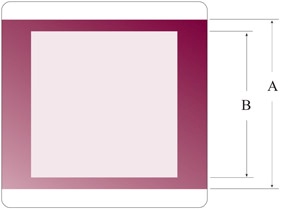
| A | B | |
|---|---|---|
|
IEC1 94-1 (pre 1985) |
6.3 mm, (0.248 in) |
6.3 mm, (0.248 in) |
| NAB 1965 |
6.3 mm, (0.248 in) |
6.05 mm (0.238 in) |
|
IEC 94-6 1985 |
6.3 mm (0.248 in) |
5.9 mm (0.232 in) |
Fig 1. section 5.4 full track head configuration and dimensions.
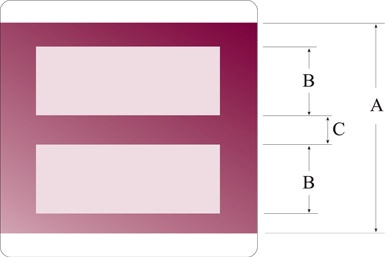
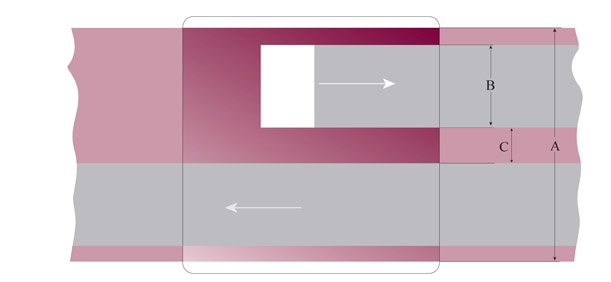
| A |
maximum recording width1 |
B | C | |
|---|---|---|---|---|
| Ampex |
6.3 mm, (0.248 in) |
6.05 mm (0.238 in) |
1.9 mm (0.075 in) |
2.14 mm (0.084 in) |
|
IEC 94-6 1985 2 track |
6.3 mm, (0.248 in) |
5.9 mm (0.232 in) |
1.95 mm (0.077 in) |
2.00 mm (0.079 in) |
| IEC home stereo (pre 1985) |
6.3 mm, (0.248 in) |
6.3 mm, (0.248 in) |
2.0 mm (0.079 in) |
2.25 mm (0.089 in) |
| NAB 1965 |
6.3 mm, (0.248 in) |
6.05 mm (0.238 in) |
2.1 mm (0.082 in) |
1.85 mm (0.073 in) |
|
IEC-1 Time code DIN mono half track |
6.3 mm, (0.248 in) |
6.3 mm, (0.248 in) |
2.3 mm (0.091 in) |
1.65 mm (0.065 in) |
|
IEC 94-6 1985 Stereo |
6.3 mm, (0.248 in) |
5.9 mm (0.232 in) |
2.58 mm (0.102 in) |
0.75 mm (0.03 in) |
|
IEC-1 Stereo (pre 1985) Mono half track |
6.3 mm, (0.248 in) |
6.3 mm, (0.248 in) |
2.775 mm (0.108 in) |
0.75 mm (0.03 in) |
|
IEC ½ inch |
12.6 mm (0.496 in) |
5.0 mm (0.197 in) |
2.5 mm (0.098 in) |
Fig 2. section 5.4 two track and half track head configuration and dimensions.
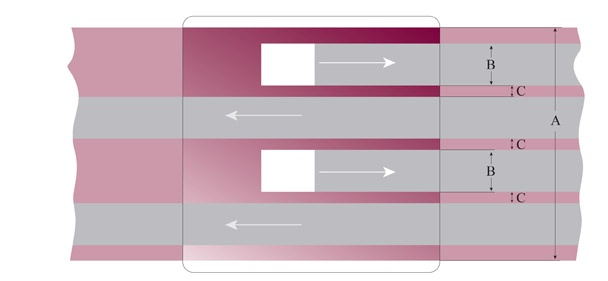
| A | B | C | |
|---|---|---|---|
|
IEC1 NAB |
6.3 mm, (0.248 in) |
1 mm (0.043 in) |
0.75 mm (0.43 in) |
Fig 3 section 5.4 quarter track head configuration and dimensions.
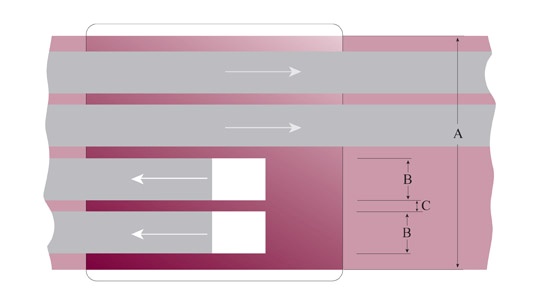
| A | B | C | |
|---|---|---|---|
|
IEC Philips |
3.81 mm, (0.15 in) |
0.6 mm (0.02 in) |
0.3 mm (0.012 in) |
Fig 4 Section 5.4 Stereo Cassette head configuration and dimensions.
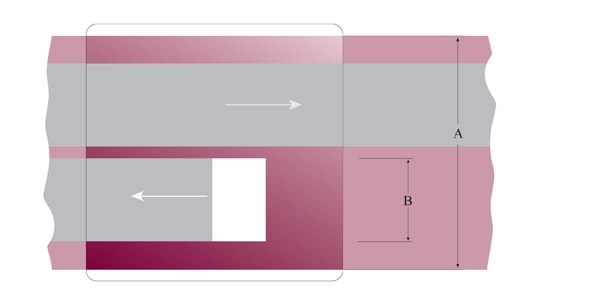
| A | B | |
|---|---|---|
|
ANSI Philips |
3.81 mm, (0.15 in) |
1.5 mm (0.06 in) |
Fig 5 Section 5.4 Mono Cassette head configuration and dimensions.
5.4.4.4 Head dimensions are specified in different ways in the European and US standards. Initially, the International Electrotechnical Commission (IEC), predominately referred to by European manufacturers, specified the tape with regard to the centre of the tape and the distance between the tracks, while the American based standards referred to the size of the recording track width defined diagrammatically with respect to one side. The size of the tape itself, has changed over time, initially a quarter of an inch, it was defined as 0.246 ± 0.002 inch (6.25 ± 0.05 mm) and later as 0.248 ± 0.002 in (6.3 ± 0.05 mm)”. IEC defines recording width in a full track recording in the following manner,”A single track shall extend over the whole width of the tape.” (IEC 94 1968:11), whereas the American based standards define the size of the recorded track to slightly less than the width of a 0.246 inch tape at 0.238 +0.010 -0.004 inch track size (this is a pragmatic solution to the problem of “grooves” in head wear and extends to all track dimensions). IEC later changed their full track width to 5.9 mm (0.232 inches). The number of standard track widths specified in figs.1 to 5 suggests that there is very little standardisation. (Eargle 1995, Benson 1988, IEC 94-1 1968, 1981, IEC 94-6 1985, NAB 1965 McKnight 2001, Hess 2001).
5.4.4.5 The net effect of replaying tapes on mismatched head widths is discussed in 5.4.2.2 above. It is important to attempt to assess the correct head width with which the original tapes were recorded and to then replay them on the most appropriate machine available. half” and 1” two track recordings are generally made in half track configuration only, and with specialised professional recording equipment with the intention of providing very high quality analogue audio. The same type and standard of equipment is required for replay, and an even closer attention to the detail of the record/replay standards.
5.4.4.6 Multitrack recordings range from domestic 1/4” standards to professional 2” and care must be taken to ensure the replay of those tapes is accurate. If time code has been recorded as part of the recording it must be captured and encoded in such a way that it may be used for later synchronisation (see 2.8 for file formats).
5.4.4.7 Tape machines should be capable of replaying signals with a frequency response of 30 Hz to 10 kHz ±1 dB, and 10 kHz to 20 kHz +1, -2 dB.
5.4.4.8 The equalisation on a reel replay machine should be capable of being aligned for replaying NAB or IEC equalisation, preferably being able to switch between them without re-alignment.
5.4.4.9 Wow and flutter unweighted better than 0.05% at 15 ips, 0.08% at 7.5 ips, and average variation from true speed better than 0.1%.
5.4.4.10 A professional archival reel machine should also have gentle tape handling characteristics so that it does not damage the tape during replay. Many of the early and middle generation studio machines depended on the robust characteristics of the modern tape carrier for their successful operation. These machines may cause damage to older tapes, or to long play tapes or thin tapes used for field recording.
1. Maximum recording width refers to the width measured from the outside edge of the outer tracks (see section 5.4.4.4)


